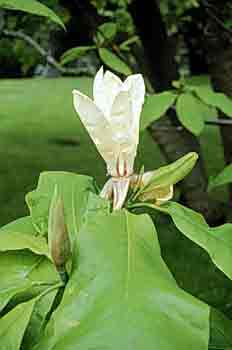 Umbrella magnolia - Magnolia tripetala
Umbrella magnolia - Magnolia tripetala
Magnolia family (Magnoliaceae)
 Native habitat: Southern Pennsylvania to northern Georgia and Alabama, west to central Kentucky, Tennessee, Arkansas and Oklahoma.
Native habitat: Southern Pennsylvania to northern Georgia and Alabama, west to central Kentucky, Tennessee, Arkansas and Oklahoma.- Growth habit: Irregular growth habit with contorted or wide-spreading branches.
- Tree size: Reaches an average height of 15 to 30 feet.
- Flower and fruit: Flowers have 6 to 9 tepals and are 6 to 10 inches across. They are creamy white and are borne in May to early June and are solitary. Flowers have an unpleasant aroma. Fruits are rosy red, cone-shaped and 4 inches long. Fruits mature in September or October.
 Leaf: Alternate, simple leaves, which are 10 to 24 inches long and 6 to 10 inches wide, are clustered at branch ends. Leaves are dark green on top and pale green on the bottom. Foliage turns brown and falls in autumn. Leaves have petioles 1 to 2 inches long.
Leaf: Alternate, simple leaves, which are 10 to 24 inches long and 6 to 10 inches wide, are clustered at branch ends. Leaves are dark green on top and pale green on the bottom. Foliage turns brown and falls in autumn. Leaves have petioles 1 to 2 inches long.- Hardiness: Winter hardy to USDA zone 4.
Umbrella magnolia is found in Great Smoky Mountains National Park, particularly on the western side. Umbrella magnolia was introduced into the landscape in 1752.
 English naturalist Mark Catesby first described the species in Natural History of Carolina, published in 1743.
English naturalist Mark Catesby first described the species in Natural History of Carolina, published in 1743.
The national champion umbrella magnolia is in Bucks County, Pennsylvania, and is 50 feet tall and wide.

